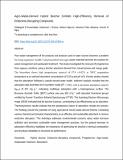| dc.contributor.author | Kasambala, Hildegard | |
| dc.contributor.author | Rwiza, Mwemezi | |
| dc.contributor.author | Mpumi, Nelson | |
| dc.contributor.author | Mwema, Mwema | |
| dc.contributor.author | Njau, Karoli | |
| dc.date.accessioned | 2025-04-22T07:16:28Z | |
| dc.date.available | 2025-04-22T07:16:28Z | |
| dc.date.issued | 2025-04-11 | |
| dc.identifier.uri | https://doi.org/10.1007/s11270-025-07960-w | |
| dc.identifier.uri | https://dspace.nm-aist.ac.tz/handle/20.500.12479/3065 | |
| dc.description | This research article was published by Water, Air, & Soil Pollution Volume 236, 2025 | en_US |
| dc.description.abstract | Poor waste management of the products and products used in water sources becomes a problem for living organisms’ health. Using biosorbent from agro-waste materials becomes the solution for waste management and wastewater treatment. This study investigated the removal of progesterone from aqueous solutions using a biochar adsorbent derived from mixed banana and mango peels. The biosorbent shows high progesterone removal of 97.8 ± 0.02% at 700℃ preparation temperature at an optimal biosorbent concentration of 0.50 g and pH of 8. Kinetic studies showed that the adsorption followed a pseudo-second-order model. Isotherm analysis revealed that the adsorption data best fitted the Freundlich model (R2 = 0.96), with a maximum adsorption capacity (qmax) of 307 mg g−1, indicating multilayer adsorption with a heterogeneous surface. The Brunauer–Emmett–Teller (BET) surface area was 652 m2g−1 with abundant functional groups verified by Fourier Transform Infrared Spectroscopy (FTIR). The Scanning Electron Microscopy image (SEM) indicated that the biochar is porous, contributing to its effectiveness as an adsorbent. Thermodynamics results indicate that the spontaneous nature of adsorption reveals the process. The findings proved the potential of using agricultural mixed waste-derived biochar containing various chemical and physical characteristics as an effective and sustainable adsorbent to remove endocrine disruptors. This technique addresses environmental concerns about water hormone pollution and promotes sustainable waste management practices, but the gradual decrease in adsorption efficiency highlights the importance of optimizing the biochar's chemical composition and structural reliability to maximize its performance. | en_US |
| dc.language.iso | en | en_US |
| dc.publisher | Springer International Publishing | en_US |
| dc.subject | Hybrid biochar | en_US |
| dc.subject | Endocrine-disrupting compounds | en_US |
| dc.subject | Progesterone | en_US |
| dc.subject | Agro-waste | en_US |
| dc.subject | Wastewater treatment | en_US |
| dc.subject | Biosorbent | en_US |
| dc.title | Agro-Waste-Derived Hybrid Biochar Exhibits High-Efficiency Removal of Endocrine-Disrupting Compounds | en_US |
| dc.type | Article | en_US |

